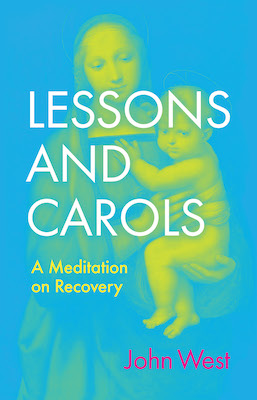interviews
Lessons and Carols for Recovery and Redemption
John West on creating art that reflects the messy reality of struggling with mental health and addiction

John West’s Lessons and Carols is a lyric memoir of recovery, parenting, loss, and hope, which is also periodically quite funny (ex. the first line of the first Lesson, “Caring for this baby has taught me new ways to resent.”) Hopscotching through time, the memoir shows us West’s first, early forays with alcohol as a shy, queer college student; the intense relationships and losses he experienced during his periods of active addiction and recovery; and his current-time adoption (with his partner) of an infant named Lavinia.
West works small. His intimate book is just 35,000 words, composed of fragments ranging from a single sentence to a few pages in length. Yet for all its patchwork nature, Lessons and Carols is tightly constructed. While a reader may occasionally feel unmoored in time, that very feeling is a tool West wields with intention: a visceral yet vicarious replication of the loss-of-time that accompanies the use of many substances, alcohol included, and which comes with the experience of trauma, too – and the exhaustion of being a new parent.
Full disclosure: I met West because we were working together at Bennington College’s Writing Seminars, where I currently teach nonfiction (and where both West and I were once MFA students). I learned West was a data scientist, with a background in machine learning and reporting (he currently works for the Wall Street Journal, where he is part of the team that won a 2023 Pulitzer for their reporting on capital assets).
I talked to John West about bringing the skills from one side of his writing life to bear on the other and how the logical and the lyrical come together to create Lessons and Carols.
Hugh Ryan: What does the title of your book refer to?
John West: Lessons and Carols refers to the Nine Lessons and Carols, an Anglican tradition dating back to the late 19th century. I’m going to tell a slightly apocryphal version of the story, but that’s fine, I think.
E.W. Benson (who would later go on to be the Archbishop of Canterbury)—his cathedral is under construction, and he’s concerned that his flock will go out drinking on Christmas instead of being good Christians and going to church. So, he says we’re going to do something really fun: we’re going to sing carols and read parts of the Bible. Big deal, I guess, in the late 1800s. It apparently worked, and he did it for one year and then stopped, but people loved it, and during World War I, King’s College in Cambridge brought the Nine Lessons back.
I don’t know if this is true in the E. W. Benson version, but it’s been true at every one I’ve been to: during the final, ninth lesson, everyone sings Silent Night, and you hold up candles, and the lights go off, and they say “And the light shone in the darkness, and the darkness did not overcome it,” and it’s just this very touching moment.
I’ve done a version of the Nine Lessons every year for almost 15 years now. We’re… pretty irreverent, actually. But we print out these books, and people have parts, and it’s a fun time—but we also sing Silent Night and hold up the candles.
HR: Another pillar of the book is parenthood. Did deciding to have a kid push you to write this? Make you more scared to write this? Have nothing to do with writing this? Do you hope she’ll read it one day?
This book is an effort to build community, and make something beautiful out of something that would otherwise be kind of tragic.
JW: I was writing this book—or a version of it—before we had a kid, but the whole thing changed the second I realized how ill-prepared I was (maybe how ill-prepared anybody is) to have a kid. This isn’t true for everyone, I don’t think, but, for me, I had to become a dad to become the me that I wanted to be. Like, I was Charmander, and now I’m Charizard, or whatever Charmander’s final form is. The same was true of the book. I hope she reads it someday; I hope she feels the love I wrote with.
HR: Are you from an Anglican background? Or what significance do the Lessons and Carols have for you?
JW: I wasn’t raised Anglican, I was raised Congregationalist. I was the assistant to the organist choirmaster at Plymouth Congregational Church in Minneapolis. That’s my favorite part of organized religion, probably: access to amazing music. So many of the great composers in the Western canon wrote religious music primarily, and that music is stirring and moving. That’s also my in to the Nine Lessons and Carols, the pageantry of it.
It’s this amazing thing, this amazing ritual that we’ve had for over 100 years—or depending how you count almost 150—where people come together, sing these songs and speak these words, and that is beautiful. I think, in some meaningful way, it provided hope to people. They brought it back during World War I because that was a dark time in Britain, and they needed something to bind the people together. I don’t want to compare my final year of college to World War I, but it was a pretty dark time when I did the first one of these.
In some ways, this book is an effort to build community, and make something beautiful out of something that would otherwise be kind of tragic.
HR: This book is about both religion and recovery (among other things), and I often wonder about the relationship between those two. For some people, a belief in a high power seems to be critical to their recovery, but I worry that ideas about “redemption” and “sin” can often leave people feeling inherently irredeemable. What’s your relationship between religion and recovery?
JW: I went through a real John Calvin phase, who wrote, “We cannot ardently desire God before we have begun to be completely dissatisfied with ourselves,” but, also, “as our abasement is His exaltation, so also the confession of our lowliness always has His mercy near as a remedy,” I take Calvin to mean that we lowly humans are irredeemable, but that it is precisely in that irredeemableness that we find an inhuman power that does redeem. A paradox, I suppose—I don’t know.
I’m less keen on Calvin than I used to be. I don’t really think all of human nature is inherently sinful. But I do think that it can be useful to recognize our own flaws and foibles as beyond a self’s power to fix, and then to locate new power in something bigger than us. Maybe that’s community, or maybe that’s god, I don’t think it really matters what or who it is.
The trouble, as I see it, isn’t so much with the concept of sin, or even with the idea that the human condition is rife with sin and always will be; the trouble is that society often extends mercy to only a few—and systems of power and oppression dictate those to whom grace is given. The wild thing about the Christian story is that Jesus went to the outcasts first, but we seem to forget that over and over again. I think the lesson, for me, is that we all get grace or no one does. No one is free until we’re all free.
HR: On a practical level, how did you find your ordering principle for the material that became Lessons and Carols?
JW: I wrote a bunch of stuff, like 20,000, 30,000 words, and asked, what’s here? There were really four things I was talking about: being a parent, addiction & mental health, the actual Christmas story of the Lessons and Carols, and people who died. I decided the first three [types of material] are going to be my Lessons, and the last one’s going to be the Carols. For those, I wrote a series of translations/adaptations of Catullus’ 101st poem, which is an elegy for his dead brother, and I rewrote that for each time a friend or someone I knew passed away or disappeared from alcohol or drug addiction.
As I wrote, I discovered new hurts. It showed the places where I still had healing to do.
That’s the macro structure, but then zooming into the micro: the book is fragmented, and keeping track of that was a nightmare. So, I made a spreadsheet, because I’m a data journalist, and that’s what I do. The spreadsheet had 160-odd entries in it, one for each fragment, and there are two taxonomies—like “tags” and “categories.” Each fragment can only have one category— the four “kinds” of material (parenting, Christmas, etc.). But the tags were a lot more freeform. They tracked my important motifs: birds, the moon, the act naming a thing or a baby, what I called “vice,” which was like basically any kind of drugs or alcohol. Etc.
HR: Ok, so let me see if I get this: You’ve written a couple of chapters, and you see that birds are appearing, so they become a theme. After that point, did you start worrying, ‘Oh, I have to have more birds,” or “now I’m stuck with birds and I want more freedom?”
JW: The lesson I learned was that constraint can be really valuable in fostering creativity. My constraint was operating in my palette. I defined it through that iterative process, but at some point, I was like, no, I’m cutting it off, this is what I’m working with now, and that proved generative. It made a closed world that I could inhabit more easily than if I had the sky as a limit, and could use any image I wanted.
In the end, I wanted to create art that reflected the kind of messy reality of what it means to struggle with mental health and addiction. For me, that meant this recursion, going back and back and back. And like, yes, things change, but also things are stubbornly always the same, and that was something I really wanted to capture. The past feels always present, and all of that trauma doesn’t just dissipate magically.
HR: Sometimes when I tell people I’m writing about something personal, they ask me if it’s cathartic, and for me, the answer is almost always no. Catharsis is something I have to reach before I’m able to write well about myself (I think about this essay by T Kira Madden, which so perfectly encapsulates this idea). This memoir is so much about being hurt and healing; what’s the relationship for you between writing and healing?
JW: Oh, I love that: Yes, I had to do the work separate from the writing of the book. And the things I kept cutting from it where the things I hadn’t yet therapized to death, hadn’t yet processed with my partner and friends. But, as I wrote, I will say, I discovered new hurts. So, in that way, it did help me. It showed the places where I still had healing to do.









